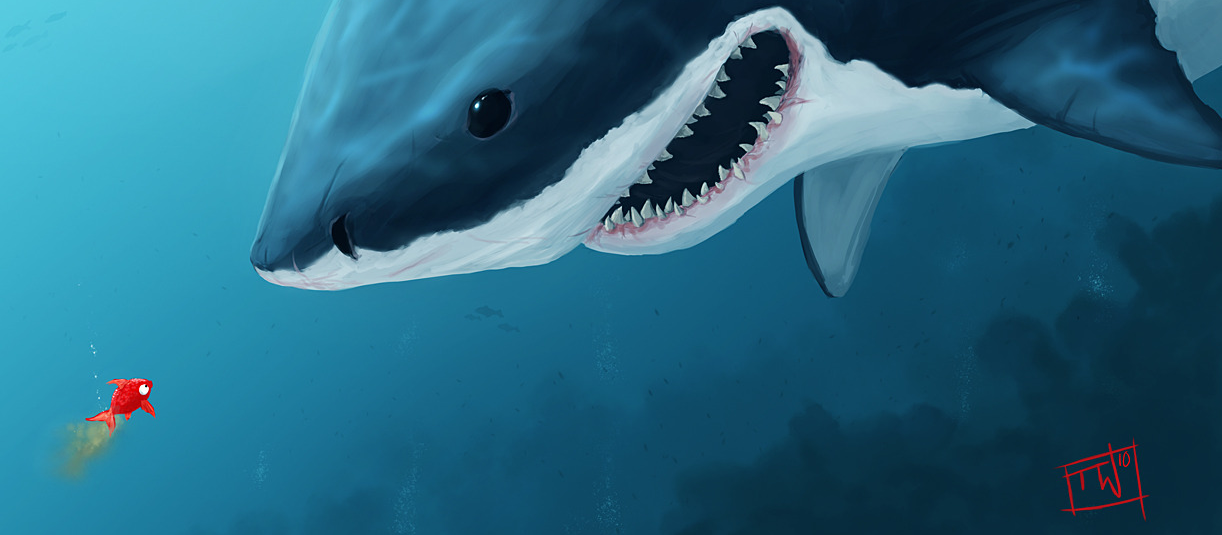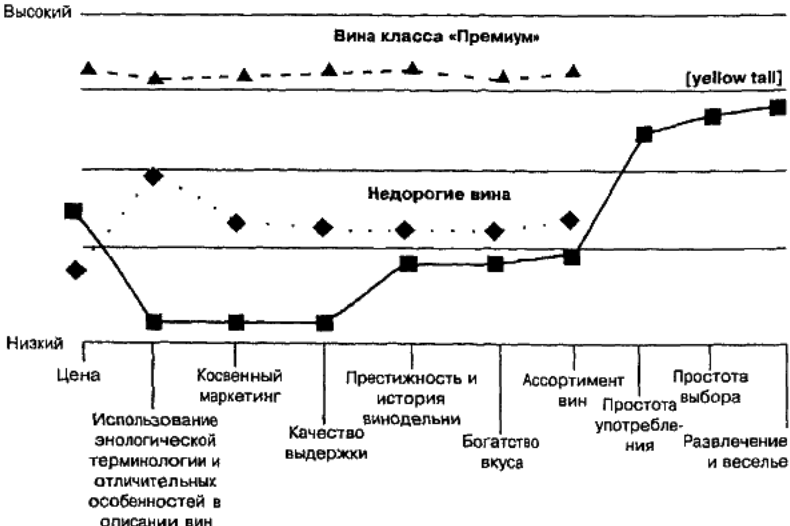"Blue Ocean Strategy." Book in 15 minutes

After the publication of our first post, we were congratulated on going to the "scarlet ocean" tearing each other apart from competitors (business sharks?).
But we decided not to despair, not waste time in vain and restore in memory the ideas from the book “The Strategy of the Blue Ocean”, useful for any
So…
"The only way to defeat competition is to stop trying to win."
The comparison of military confrontation and market competition is firmly rooted in the mass consciousness and seems quite logical. Competitive companies are enemies fighting each other on the battlefield. They are trying to win back their part of the territory - market shares, releasing substitute products or offering similar services with minor modifications or at a lower price. A market crowded with competitors tearing each other apart looks like a bloodshot red ocean.
Many books and manuals have been written that describe strategies for doing business and competition in the scarlet ocean.

The book “The Strategy of the Blue Ocean” offers a different approach - to go beyond the known market sectors and the paradigm of fierce competition of the scarlet ocean and concentrate our efforts on untouched areas, the so-called blue oceans, where there are no competitors, but there is huge potential for the development of the company.
In the blue oceans, competition does not threaten anyone, since the rules of the game have yet to be established.
To clearly demonstrate the idea of the blue ocean, the authors cite as an example the circus industry, which, due to more modern hobbies of children, was rapidly losing its popularity.
However, Cirque du Soleil has achieved incredible success in a seemingly doomed industry. What is the secret of her success? The company did not go on the beaten track and did not use such classic elements of the circus as round arenas, performances of animals and clowns. Cirque du Soleil has incorporated the best elements of the circus and theater - acrobatics of the highest level and vivid conceptual representations, and got rid of everything that did not fit into the framework of her new concept.

Moreover, the company changed the target audience of the circus, switching from children to solvent adults. In fact, Cirque du Soleil invented the circus anew, opening up an unoccupied niche. As a result of this original approach, it took Cirque du Soleil less than 20 years to exceed the revenue that only well-known circuses such as Ringling Bros. managed to achieve in more than 100 years of their performances. and Barnum & Bailey Circus.
There are a considerable number of other examples of the creation of blue oceans. For example, the natural cosmetics company The Body Shop or Southwest Airlines, which made low-cost flights fun and profitable.
It is important to understand that the concept of blue oceans does not deny the role of a familiar competitive environment. But when in a certain industry supply begins to exceed demand, actions aimed at combating competitors are no longer enough for full-fledged business growth. For further development, companies need to focus on creating blue oceans.
How to create a blue ocean
To create a blue ocean, it is not at all necessary to open a new industry, since most often companies create blue oceans inside the scarlet, pushing existing industry boundaries as Cirque du Soleil or The Body Shop did.
The blue ocean strategy is based on value innovation. Value innovation is not a competitive advantage, but something that makes competition simply unnecessary due to the company reaching a whole new level.
In contrast to the classical competitive approach, to use the strategy of innovation of value, it is not necessary to choose between low costs and high value. This strategy allows you to simultaneously create high value at low cost.
Strategic canvas
The main tool for building a strategy for value innovation is the strategic canvas. The strategic canvas is a simplified industry model, graphically presented. It allows you to evaluate the similarities and differences of your strategy with the strategies of competitors.
The construction of the strategic canvas is as follows:

Firstly , you should highlight the key industry factors common to your proposal and to the competitors' offer (and place them on the graph along the horizontal axis). For example, for food, this may be the cost, taste, assortment, packaging, prestige of the company, etc.
Secondly , you need to evaluate the cost or volume of the offer (for example, a wide range or narrow, high or low price) for each highlighted in the first paragraph specifications. The vertical axis will also show the assessment of these factors.
For example, the higher the price of the product, the higher the location of this factor relative to the vertical axis.
Thirdly, you need to connect the resulting points on the graph for each company. The resulting curves are, according to the terminology of the authors, “crooked values”. They are a visual representation of the strategies of a particular organization or group of companies.
Images of value curves for competing companies from the scarlet ocean will have a similar shape (and may even overlap), in contrast to images of value curves of those companies that have implemented value innovation.
Thus, the strategic outline is not only a reflection of the current state of affairs in a particular industry, giving a visual representation of the actions of competitors.
It is also a convenient tool for developing a new alternative company strategy.
If you are aiming at creating a blue ocean, then your strategic canvas should not be like the strategic canvas of competitors. How to do it?
Neither price cuts nor consumer polls will be an option. “Studies have shown that consumers usually express a desire to get more of what they already have. And regarding what still does not exist in the market, they cannot advise anything. ”
Creating a blue ocean requires deeper changes - reorientation from competition to the search for alternatives and reorientation from attempts to satisfy typical industry customers - to make customers who had no previous relationship with it.
A case in point is the Australian company Casella Wines, which, having decided to enter the American wine market and having studied the industry factors, did not repeat the model of the competitors strategic canvas - to sell expensive and aged wine for connoisseurs, and, significantly changing the position of the strategic canvas factors, created a new industry - wine for people who do not understand it. The company began to produce wine for everyone - wine that is convenient to drink at parties along with beer and cocktails.

As a result, in two years the wine for parties, [yellow tail], became the fastest growing brand in the history of the Australian and American wine industry, as well as the main wine imported into the United States, ahead of French and Italian wines.
Four Action Model
The four-action model is a logical continuation of the strategic canvas.
After the analysis of their current market position and the position of competitors, you should ask yourself four questions:
1. What competition factors, defined and accepted in the industry, can be eliminated?
For example, the abolition of waiters in fast food restaurants.
2. What factors of competition should be significantly reduced in comparison with industry standards?
For example, the richness of the taste of wine, the assortment and the aging time, as in the example of Casella Wines.
3. What factors should be significantly increased compared to industry standards?
For example, when creating an online iTunes music store, Apple significantly enhanced key factors such as high sound quality; wide range of melodies; the possibility of buying thematic collections of songs.
4. What factors from never before proposed by the industry should be created?
For example, NetJets airline has created a unique offer for corporate clients - shared ownership of aircraft, which allows customers to save time that would be lost in the queues on regular commercial flights, and money, since the NetJets offer was much cheaper than the cost of maintaining their own aircraft.
The first two questions help identify possible ways to reduce costs that competitors are not paying attention to. The last two questions are aimed at finding an increase in the value of your offer for the buyer and at creating new demand.
The principles of creating blue oceans
The creation of blue oceans requires the observance of six principles.
Principle 1: reviewing the boundaries of an existing market
It can be implemented in several ways:
1. Pay attention to alternative industries.
An example of alternative industries is restaurants and cinemas. These are different industries, but from the point of view of a pleasant pastime for the client, they are alternatives.
The key to finding the right alternative is to see and understand the factors that force buyers to choose between alternative industries.
2. The second way is to consider the so-called strategic groups - companies and industries that have similar strategies.
For example, in the automotive industry there is a strategic group of luxury cars and a strategic group of cheap ones. Competition is within these groups: luxury and cheap cars compete only between companies in their categories.
The key to creating a blue ocean in such conditions is to find out what guides customers choosing between one group or another.
A good example of the successful implementation of this path is the network of inexpensive fitness clubs for women Curves. The company created a popular format for fitness clubs, finding out that women want to look good and fit, and for this they prefer to attend fitness clubs rather than doing video lessons because of many factors that distract them at home. But at the same time, in standard fitness clubs they are confused by the opportunity to look not the most attractive way in the eyes of men visiting fitness clubs. Curves offered a way out - inexpensive fitness clubs exclusively for women with simple fitness equipment. Thus, the company has adopted the key factors of two strategic groups of the fitness market - expensive fitness clubs and video lessons for independent sports.
3. The third way is to pay attention to the chain of customers. In certain industries, companies are focused on certain segments of customers - someone is focused on large sales, and someone on individual. Often, the buyer and the user are different persons, which makes it possible to take into account that group of buyers with which competitors do not work. So, the Danish insulin manufacturer Novo Nordisk, thanks to its NovoPen product (insulin syringe pen), was able to work directly with diabetics bypassing the usual scheme of selling products through doctors.
4. The fourth way is to consider introducing additional products or services. For example, the large bookstores Borders and Barnes & Noble made shopping a more enjoyable process by equipping their halls with sofas and armchairs and opening coffee bars.
5. The fifth way is to analyze the functional and emotional appeal of the product to customers. The possibility of creating a blue ocean here appears due to the violation of the usual ways of competition, which address either the price and functions (functional attractiveness), or the feelings and emotions of the buyer (emotional attractiveness).
Creating a blue ocean is possible if you add an emotional component to a model focused on functionality or vice versa, and thereby push the boundaries of the market and stimulate new demand.
The two most famous examples are: Swatch, a company that influenced the function-oriented industry of low-cost watches to become an emotionally-oriented trendsetter, and The Body Shop, which acted in the opposite way, transformed from an emotionally-oriented cosmetics company to a functional business style House of cosmetics.
6. The sixth and most difficult way is to try to look into the future. Its essence is not just to predict future changes and adjust to them, but to analyze how the existing new trend will change the market in the future and how it can affect the company's business model and the value of its offer to customers.
A good example of the implementation of this path is CNN, which was the first to switch to a round-the-clock broadcasting format, correctly assessing the global trends in the information market.
Principle 2: focusing on a holistic picture, not numbers
This is not easy to do, as the strategy building scheme of most companies is firmly connected with the scarlet oceans of existing markets.
“Imagine a typical strategic plan. It begins with a long description of the conditions existing in the industry and the company's position in relation to competitors.
Then there is a discussion of how to increase your market share, conquer new segments or reduce costs, after which there are sketches of countless goals and initiatives. ”
In order not to get bogged down in statistics, instead of a generally accepted approach to building a strategy, use focus on the overall vision of the picture of your development. The most convenient and visual way to do this is to build a strategic outline on the chart using the method described above. This will help to demonstrate the strategic profile of the industry, the strategies of competitors and their own strategies at this point in time and in the future.
In order for the chosen strategy to have potential for growth, it must correspond to three parameters:
1) the strategy should be focused on a specific factor of the industry, and not be sprayed on everything;
2) the strategy should be different from the strategies of competitors and, accordingly, the company's value curve should not overlap with competitors' value curves;
3) the strategy can be expressed in the form of a clear and attractive motto.
Principle 3: Exceeding Existing Demand
Most companies focus on meeting the needs of a traditionally established type of customer. However, as the authors emphasize, such a strategy ultimately leads to deeper market segmentation, which is why business growth is naturally slowing down.
Therefore, for a company aimed at creating a blue ocean, it would be wise to pay attention to non-clients of the industry. And instead of striving to satisfy all possible inquiries of existing customers, it is necessary to find something in common that could be appreciated by those who are not currently related to industry clients. So, Cirque du Soleil switched from children - the usual customers of circuses, to solvent adults, and Cassella Wines began to sell wine to those who did not drink it before.
Principle 4: the right strategic sequence
The essence of this principle is to test the commercial viability of the idea of the blue ocean and determine whether your proposal is not just an innovation, but an innovation of value for the buyer.
In order to structure this process, the authors propose asking themselves four questions in order:
1. Does your offer have exceptional utility for the buyer?
2. Is the price you set suitable for the bulk of customers?
3. Do costs allow you to make a profit?
4. What obstacles impede the implementation of your proposal? Can they be thought out in advance?
A successful blue ocean strategy implies positive answers to all four questions.
Principle 5: Overcome Organizational Conflicts
Implementation of any strategy is accompanied by significant difficulties, and the implementation of the blue ocean strategy is fraught with even greater difficulties, as it involves a change in the usual approach to transformation. Naturally, in such cases, companies, among other things, have to deal with internal resistance to innovation.
The authors name four main contradictions that impede the implementation of the blue ocean strategy:
1. Internal resistance of employees who need to be convinced of the correctness of the strategy change.
In order to overcome this contradiction, the authors recommend using “focused leadership”, which allows for more rapid and less costly implementation of fundamental changes. The essence of purposeful leadership is the ability to encourage other people to adopt a new strategy not at the expense of schedules, plans, numbers and abstract categories and appeals, but through the acquisition of their own experience. For example, New York Police Chief Bill Bratton during the period of necessary reforms forced the entire leadership to move only on the subway.
The police leadership had to deal with aggression, begging and hooliganism every day, which ultimately accelerated the adoption of a new work strategy.
2. Limited resources. This refers to the widespread belief that major changes require large expenditures.
In order to change the company's strategy, having only limited resources, it is necessary to concentrate on the resources already available and direct them to the so-called hot spots - those areas of activity that bring the greatest return at the lowest cost (the opposite is “cold spots”). So, the chief of police in New York Bratton sent the largest number of police to the most dangerous metro stations, while before the police were distributed evenly across the stations.
3. Motivation - it is necessary to motivate key employees to actions that contribute to the implementation of the strategy.
To overcome the problem of motivation, the authors recommend focusing on three tasks:
- Firstly, to find among the employees of companies natural born leaders who are respected and respected.
- Secondly, according to the authors, these people must be "placed in the aquarium", that is, to create such working conditions for them that make them be in sight and be responsible for their actions.
- Thirdly, in order for tasks to appear more feasible, complex tasks must be broken down into small ones.
4. Political intrigues - there is opposition from those whose interests are affected by the transformations. "The main principle in the fight against intrigue is not to fight them alone."
In order to overcome this serious obstacle, you need in advance:
- resort to the help of those who benefit from a change in strategy;
- neutralize and isolate those who lose the most from it;
- Enlist the support of experienced employees who are experienced in political intrigue.
Principle 6: integrating the implementation process into a strategy
Without the support of company employees, any strategy, no matter how good it is, is doomed to failure. Therefore, it is necessary to overcome the possible distrust of the company employees. Standard methods of positive and negative motivation in this case will not work. The alternative proposed by the authors is a “fair process”. Its essence is to attract employees to their side even at the stage of creating a new strategy due to the principle of three "E":
- Engagement - means that employees participate in strategic decisions;
- explanation (Explanation) - means that all interested employees of the company must understand the reasons for implementing the new strategy;
- Expectation Clarity - means that employees must clearly understand their goals, responsibilities and responsibilities for fulfilling them in connection with the implementation of the new strategy.
Blue ocean life cycle
Of course, competitors and imitators do not sleep, and you need to be prepared for their appearance, and for the fact that the blue ocean will sooner or later become scarlet.

In order not to lose sight of this process, the authors recommend regularly monitoring the value curves. If your curve begins to merge with the curves of competitors, then this is a sign that your work efficiency is decreasing, and it's time to look for ways to create new market spaces.
You should always remember that the search for the blue ocean is not a one-time process, but a dynamic one.
About us
We talk about key ideas from the best non-fiction books. Our library has more than a hundred best-sellers, including those that have not yet been published in Russian.
Subscribe to our telegram channel to keep abreast of all the latest business literature novelties, as well as exclusive materials from our library.
